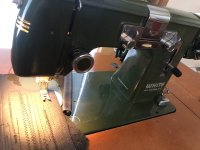Would a Necchi Lelia 510 sew leather? Thanks
Would a Necchi Lelia 510 sew leather? Thanks
I would say yes, yes it would. With some caveats. I'm not talking about belts or saddles, but for upholstery it should work well. The ones I've seen have a 1 amp motor instead of the 1.1 or 1.2 amp motors on the SuperNovas I have. But this is a straight stitch only machine so there's no power lost to running the cam mechanism (decorative stitches) so the net power to the sewing guts could be about the same. This model was introduced in 1961. It should be a fine machine if not abused.
Here's a PDF on another way to pack a machine for shipment. If you buy online, insist that they pack it properly with some form of double boxing.




